Shopify vs Etsy, two of the best eCommerce platforms in the market often have new online sellers/businesses confused – Should you choose Shopify and create your own store or get listed on Etsy to sell products? It’s a long unending debate but in this article, we’ll put an end to this debate.
Shopify is an eCommerce website-building platform where you create your own store and sell your products. Etsy on the other hand is a marketplace like Amazon that lets you list and sell your products. You can also create your separate website using the Etsy pattern. Both online channels help reach potential customers but the underlying methods are different.
Let’s get started.
Table of Contents
Shopify vs Etsy: Overview
Shopify
Shopify is an e-commerce website builder founded in 2004. The platform was developed to allow creative people to become entrepreneurs to create their online storefronts. It is totally up to you how you want to design your store. Shopify has tons of tools that help display the products, define the brand, and promote the products.
Plus, Shopify has many integrations that can further develop your store’s functionality and collaborate with different software. It is suitable for large as well as small businesses. It already serves over 3.76 million active websites and has processed over $82 billion in transactions.
Shopify has permanently captured its place in the market and taken the world by storm. Well, it’s not surprising as they make it so easy to create an online store and give infant entrepreneurs a chance to compete against the ”big boy” brands. If you want to explore more about Shopify, read our Shopify Review.
Etsy
Etsy is a platform for artistic souls, a marketplace for independent crafts and handmade products, and those who like to collect vintage items. It allows you to promote and sell vintage items and handcrafted products alongside many other artisans.
More than 7.4 million sellers sold goods to over 96 million buyers worldwide. Etsy rules the party when it comes to handmade items in the marketplace. Although it invites sellers of any size, it is best suited for small-time sellers with limited stock.
One thing to keep in mind is that Etsy is exclusively for handcrafted items and unique vintage products. So, if you are not thinking of following this line, you need to search for some marketplace alternatives for Etsy.


Shopify vs Etsy: Pros and Cons
Like every other website, Shopify and Etsy have also got some pros and cons of their own. But this does not mean that one website is better than the other, but rather a more detailed description of what each platform entails so that it is easier for you to choose what suits you the most.
Shopify: Pros and Cons
| PROS | CONS |
|---|---|
| Suitable for all sizes of businesses. | More expensive than competitors. |
| Multi-Channel selling | Not intuitive. |
| More than 8000 apps for integration. | Highly reliant on app integrations. |
| Over 100 payment solutions. | Fewer free themes. |
| 140+ well-designed modern themes. | Steep learning curve. |
Etsy: Pros and Cons
| PROS | CONS |
|---|---|
| Very big audience base | Limited Inventory option |
| Affordable plans | High transaction fees |
| Easy to get started | Limited e-commerce features |
| Etsy Marketplace access | Highly competitive |
| Good seller support | No design flexibility |
Shopify vs Etsy: Ease of Use
Shopify is known for its user-friendly interface and is a popular choice for beginners looking to start an eCommerce business.
It is a self-hosted platform, which means that it takes care of the technical aspects of setting up a website, such as hosting and security, making it much easier to use compared to open-source platforms like WooCommerce. As a result, Shopify has become a trusted choice for millions of businesses around the world.
There’s definitely a learning curve but with its intuitive interface and easy-to-use features, it is possible to get a store up and running on Shopify in a matter of minutes.
If you’re curious about the user-friendliness of Shopify, you can try the platform for free and check out the features, themes, and how much customization you can make to gauge if it suits your need. If you’re wondering how to get started with Shopify, read our Shopify Review.
In our testing, we still found Shopify to be a bit frustrating, and making visual changes took time and learning. However, Shopify is undoubtedly leagues better than BigCommerce and Weebly.

Etsy isn’t complicated either. The process of starting a store is quick and straightforward. You sign up to create an account, give your store a name, add products, and set up payment. That’s it.
The icing on the cake is Etsy will guide you throughout the process, ensuring you’re doing it right. A progress bar with checkpoints lets you fill in different information.
If you have trouble finding a good name, but your suggested name is already taken, Etsy shows alternate names you can choose from. Once you’re done with all checkpoints, you’re all set to sell.
Another reason why it is helpful for beginners is that you don’t have to create a complete website to start a store.
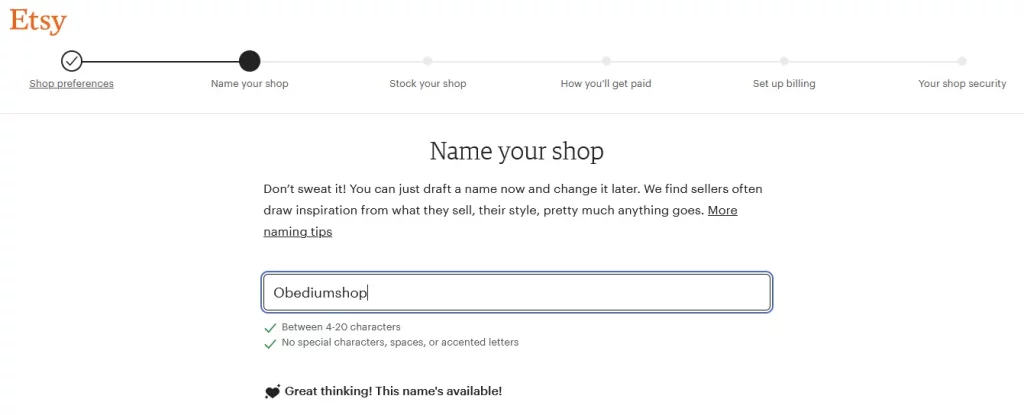
Pattern by Etsy
Apart from creating and listing products on the marketplace, Etsy also has an e-commerce platform known as Pattern by Etsy. This means that creators of handcrafted items can sell their products in the marketplace and set up an independent storefront of their own with the help of Etsy Pattern. It is free for the initial 30 days, after that $15/month is charged.
Etsy’s Pattern is an additional element developed for those already using it as a platform for selling. It is not as customizable and sophisticated as Shopify, but there are fewer restrictions here as compared to the Etsy marketplace, such as:
- You can sell anything you want to and not just handcraft or vintage items.
- There is sole ownership of the brand and store.
- Full ownership of the customer data.
To create an Etsy pattern store, you need to have one seller account on the Etsy marketplace and have at least one product listed before you go for Pattern.
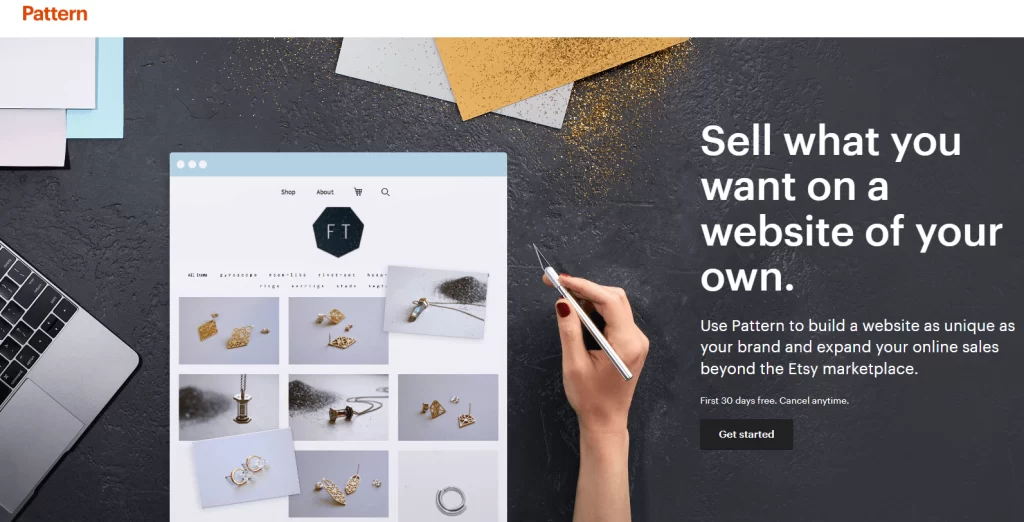
Shopify vs Etsy: Design and Flexibility
On Shopify, the simplest way to improve the appearance of your store is to use a custom theme, which can give your store a professional and polished look.
By investing in a high-quality theme, you can make your store more appealing to customers and increase the chances that they will return to make additional purchases.
Shopify themes are known for their clean, elegant, and attractive designs. They are created by professional designers, so you can trust that they will be functional and easy to use.
To edit a template, you can use Shopify’s dragdropr (drag and drop) to adjust elements and make the template work according to you.
If you’re not sure that investing in a premium theme is worth it, you can try out one of the free themes available on the Shopify platform.
Free themes, such as Sense, Debut, and Dawn, can provide a good starting point for your store and allow you to see how a new theme can improve its appearance. You won’t get as many free themes as Shift4Shop but you’ll get more customization.

Etsy doesn’t offer design customization as standard, which is both a pro and con. It doesn’t sound concerning at first because you don’t have to meddle in the tiresome designing process of the website. On the other hand, it is frustrating not to stand out from the rest.
The only customization options that come as default are the logo, store name, products, and descriptions. Etsy offers a clean and engaging design with an excellent user experience.
However, if you can’t go on without customization, you can subscribe to Etsy Pattern, which costs $15/month. It lets you use a custom domain, edit the Homepage and about page, and create gallery and contact pages.

Shopify vs Etsy: Marketing Tools
E-commerce features are good to have, but without proper marketing, even the most beautiful stores get unnoticed. To grow your store and be visible to the audience, you may need certain marketing features:
Search Engine Optimization
Shopify includes various marketing and SEO tools to help users promote and grow their online stores. These tools can be handy for small businesses and entrepreneurs looking to establish an online presence and reach a wider audience.
However, Shopify lacks in terms of keyword optimization and support, something that’s offered by Shopify’s closest competitor, Big Commerce. Some of the key marketing and SEO features offered by Shopify include:
- Blogging tools
- Reporting or Analytics tool
- Email Marketing integration
- Multilingual website option
To determine the effectiveness of your SEO efforts, it is important to use reporting tools that provide insights into how visitors are interacting with your website. These tools can help you identify what is working well and what may need improvement.
In some way, Etsy gives an advantage right from the start. When you publish your products with good titles and descriptions, Etsy puts your store in front of almost 100 million buyers. That’s exposure from day one. The only SEO you want for the Etsy marketplace is the correct product title and descriptions. Shoppers can search in the Etsy marketplace to find the products and buy them. This will also help you rank on Google for your products.
That’s where the problem begins. Since the search results on the Etsy marketplace won’t just show your products, but from other sellers, too, there is no guarantee they’ll buy from you. It’s not all gloom and doom, though. Etsy offers two advertisement options: Etsy Ads and Offsite ads.
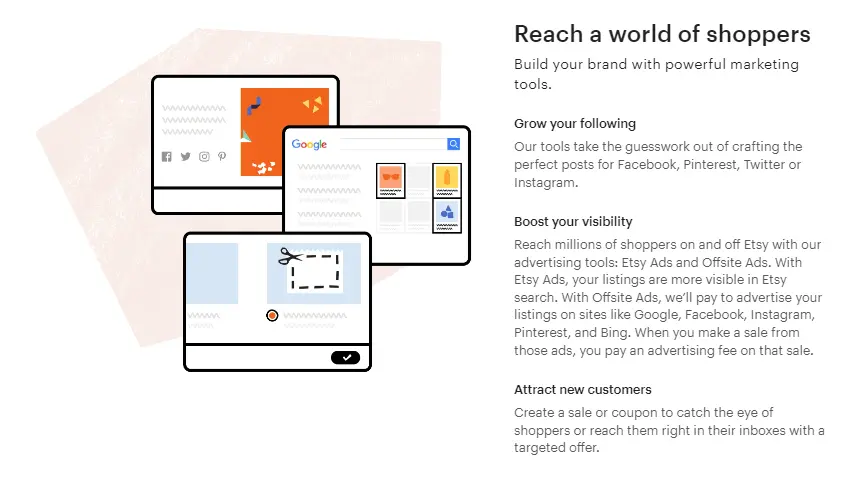
Mobile App
Shopify has a dedicated mobile app that allows you to sell on the go and edit your store’s theme. You can adjust the layouts, arrange or rearrange items/elements and even install a new theme. Here are all the things you can do on Shopify Mobile App.
- Manage and track orders: You can easily manage and track your orders, ensuring smooth order fulfillment.
- Process payments: The app allows you to process payments securely, providing a seamless checkout experience for your customers.
- Add new products: You can add new products to your online store directly from the app, making it convenient to expand your product catalog.
- Customize your online store: The app lets you customize your store, updating the store’s appearance and branding.
- Run marketing campaigns: You can run marketing campaigns and promotions to attract and engage customers, helping you boost your sales.
- Check Analytics and Reports: From the app, you can see how your store is performing, including sales data, traffic analytics, and other key metrics.
- Check Store Notifications: Stay informed with push notifications, receiving alerts for new orders, abandoned carts, customer inquiries, and other important updates.
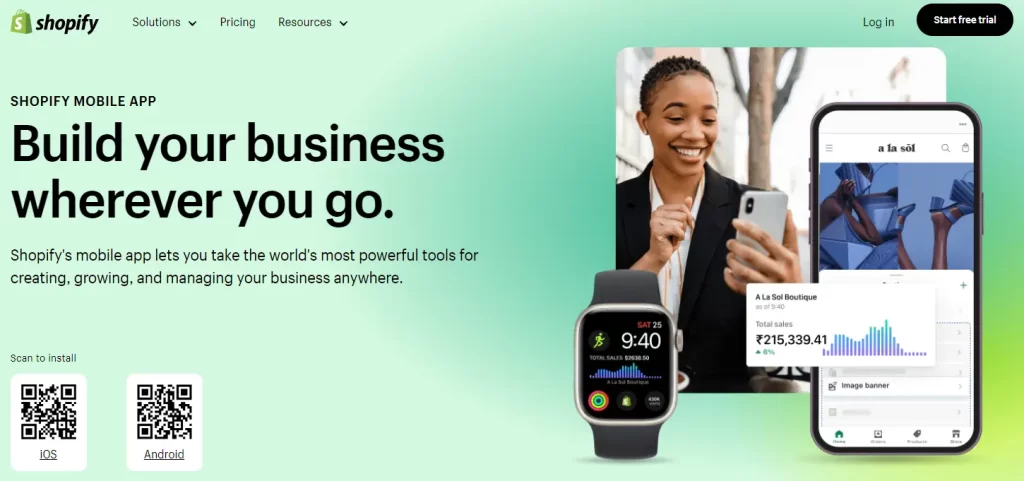
Etsy also offers a mobile app for sellers, Etsy Seller App. Like many others, it lets you manage your store on the go and do many other things which otherwise wouldn’t be possible without a laptop.
- Manage Orders: Every time an order is placed, you can check that on the mobile app and process it for taxing and shipping.
- Track Packages: Track the shipped orders to ensure smooth order fulfillment.
- Customer Management: If a buyer messages you, you can check that and even access the order details to assist them efficiently.
- Manage Products/Inventory: You can easily manage your product inventory, add or subtract SKUs, and update or change product images, titles, and descriptions.
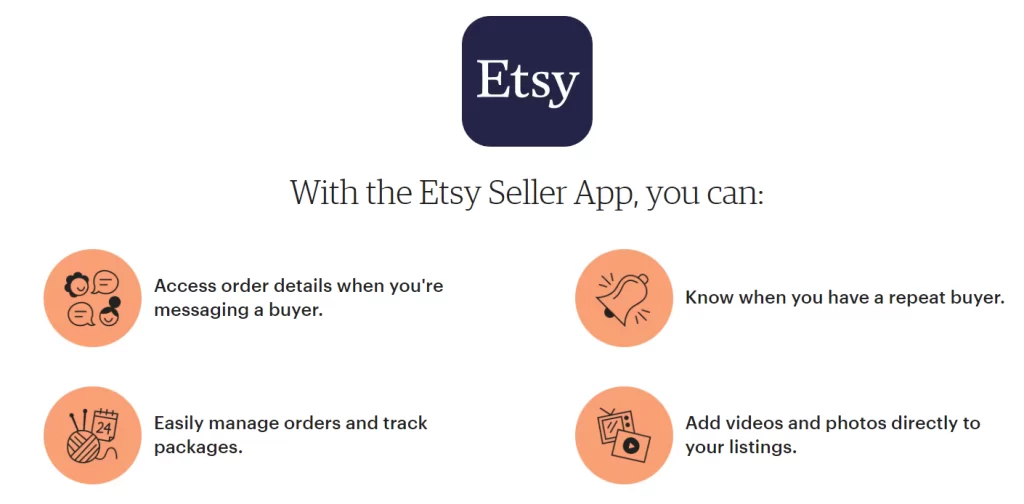
Email Marketing
Shopify offers a built-in email marketing feature, however, it requires a bit of coding. If you want to use email marketing but don’t want to code, the easiest way is to use third-party apps.
Some popular options include Seguno, Klaviyo, Campaign Monitor, Constant Contact, and Privy. These apps provide comprehensive email marketing solutions and integrate seamlessly with your Shopify store.
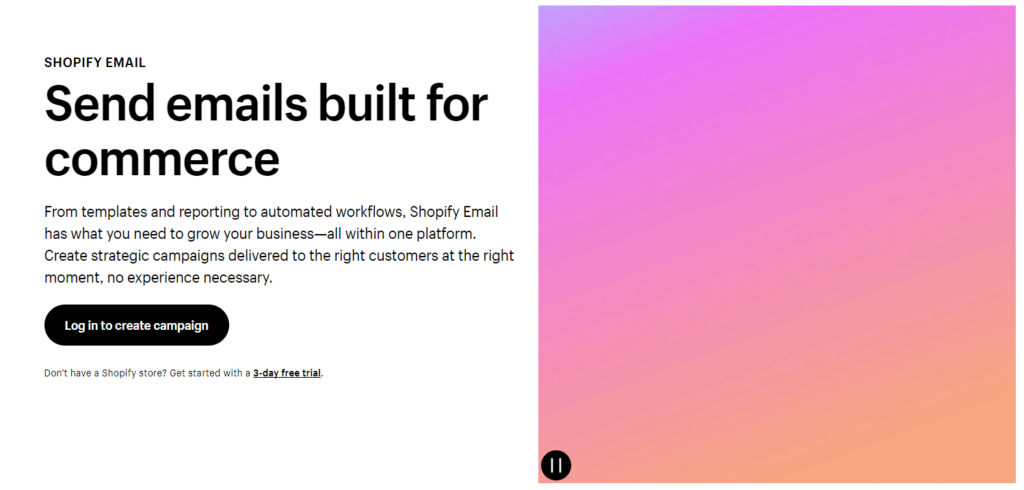
Etsy doesn’t have an inbuilt email marketing tool feature. Instead, you have to rely on third-party app integration. Adding email service providers like Mail Chimp or Craftkit is fairly easy from the dashboard, and the whole process can be finished within minutes.
Blogging
Shopify does offer blogging functionality and a decent range of tools, but it is not its strongest offering. Shopify blogging is much better than some competitors like Shift4Shop, Volusion, or BigCommerce. And yet not as good as Squarespace or Wix.
What else won’t you get? Reporting and analytics option for your blog.
Similar to Shopify, Etsy, too, lacks a blogging feature. In order to host a blog, you can either use WordPress or buy Etsy Pattern.
Shopify vs Big Cartel: Payment Processors
Shopify Payment is Shopify’s in-house payment solution for online credit/debit card transactions. It is also the only payment solution where Shopify doesn’t charge a transaction fee.
Let’s say you want to use other third-party payment options. In that case, Shopify will charge 2%, 1%, and 0.5 transaction fees in Basic, Shopify, and Advanced plans.
There’s also a transaction fee when a customer buys a product using a credit card. The fees are:
- Basic: 2.9% and $0.30 for online, 2.7% for in person
- Shopify: 2.6% and $0.30 for online, 2.5% for in person
- Advanced: 2.4% and $0.30 for online, 2.4% for in person
This transaction fee is nothing to be worried about as it is quite normal. Every time someone buys a product online or offline using a credit card, the processing fee is charged. Similarly, on Shopify, the transaction fee is charged. These fees help Shopify operate your store.

Etsy doesn’t have any hidden monthly charges. It costs $0.20 for every product you list and publish. This cost remains active until 4 months or until you sell your products.
The listing charge isn’t the only charge. When you make a sale, you pay a 6.5% transaction fee along with 3% and a $0.25 processing fee. The providers, like your credit card company or bank, charge the payment processing fee. You’ll find payment processing with almost every e-commerce platform. However, Etsy’s rates are slightly higher, which is a drawback.
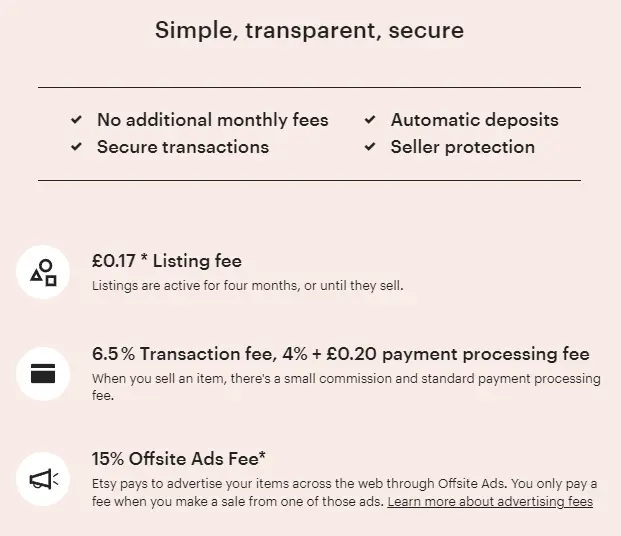
Shopify vs Etsy: Pricing
When choosing a plan, you need to be very careful about it. You don’t want to choose a plan in which you require any more features in the future, and you also would not like to waste your money on features or tools you will not use soon. And don’t forget about the monthly subscription fee you will be charged for.
Shopify Offers
- Shopify starter at $5/month: In this plan, sales can be processed through the same website or Facebook. For each transaction, 2.9% is taken by Shopify along with another $0.30.
- Shopify Basic at $29/month: A website of Shopify and the transaction fees same as of Shopify Lite. In this plan, users can also benefit from the provided two employee accounts and can also use the discount codes.
- Shopify a $79/month: There is a drop in the transaction fees in this plan which is 2.6% and $0.30/transaction. Get all the features of basic Shopify and accounts for five employees plus gift cards.
- Advanced Shopify a $299/month: Transaction fees are reduced to 2.4%, along with $0.30 for every transaction. You also get accounts for fifteen employees plus advanced reporting options to level up your sales performance.
- Shopify Plus: This is for sellers with a high volume of sales and a huge amount of transactions in a minute. The fees and all other associated costs are flexible and vary from seller to seller and his needs.
Shopify also offers a 3-days trial and 3 months subscription at $1/month.

Etsy doesn’t charge a dime to get started. One can say it is free, and it is to some extent. You first start seeing charges when you list and publish a product and make a sale. There’s a listing fee for every product you publish. For every sale, there’s a transaction and a payment processing fee. The transaction cost isn’t significant if you’re running a small store selling low volumes. However, the costs add up when you sell in high volume.
However, if you decide to go for Etsy Pattern for more customizations, you’ll have to pay $15.00/Month.

Shopify vs Etsy: Customer Support
Shopify offers comprehensive customer support with help materials available in 21 languages. The support staff is available 24/7 and can be contacted via email, live chat, or phone. Remember, the 24/7 phone support is available in English only.
Shopify’s support offering is superior to some of its competitors, such as Squarespace, Big Cartel, or Etsy, as they do not offer phone support. Connecting with a representative is fast, and efficient on Shopify.
With Shopify support, we found that for more technical inquiries, such as help with CSS or other coding elements, the standard support service may not always provide the desired answers.
If you face technical problems, asking questions in the Shopify community could prove to be more helpful than queuing with support.

Etsy offers decent support options but nothing that would blow your socks off. You can reach their customer support either by email, callback request, or by a live chat option. It has a help center where you can look for answers. You can go to the Etsy forum and join a community to participate in a discussion, ask questions for help, and learn more.
The email takes time to answer your query, 1-2 days but is available 24/7. The chat option, however, is only active 12 hours a day.
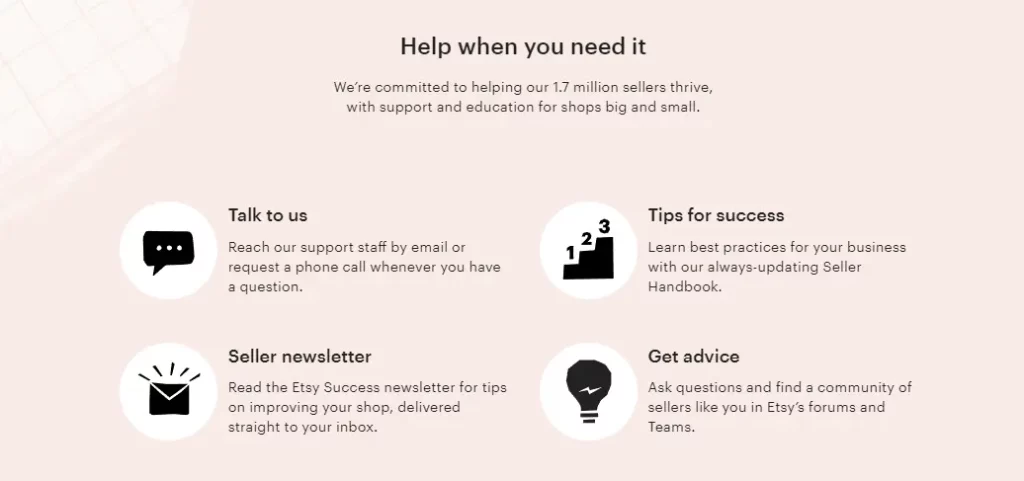
The Bottom Line: Shopify vs Etsy: Which One Is the Best for Creative Seller?
Shopify wins the debate if you are comparing and counting the features. It is more scalable and is right for you if your business is growing or if you are a large enterprise. But, not everyone can spend nearly $100 every month for a business they are just starting. To top it off, if you want to start small and just want to try out your products how they do in the market, then maybe Etsy is the choice for you. But Etsy’s limited control and highly competitive marketplace is yet another challenge.
Overall, Shopify emerges as the winner since its scalable for every business size. With loads of features and extreme customization compared to Etsy, gives Shopify an edge, hence making it an ideal choice.
If you’re very low on budget or just want to try out an e-commerce platform and sell vintage or antiqueties or handmade producst, go for Etsy. It lets you sell products for a small listing fee of $0.20/item, and the paid option, Etsy Pattern, is also affordable. However, if you have an existing store and want to expand or open a store and sell many items, Shopify is the way to go.
